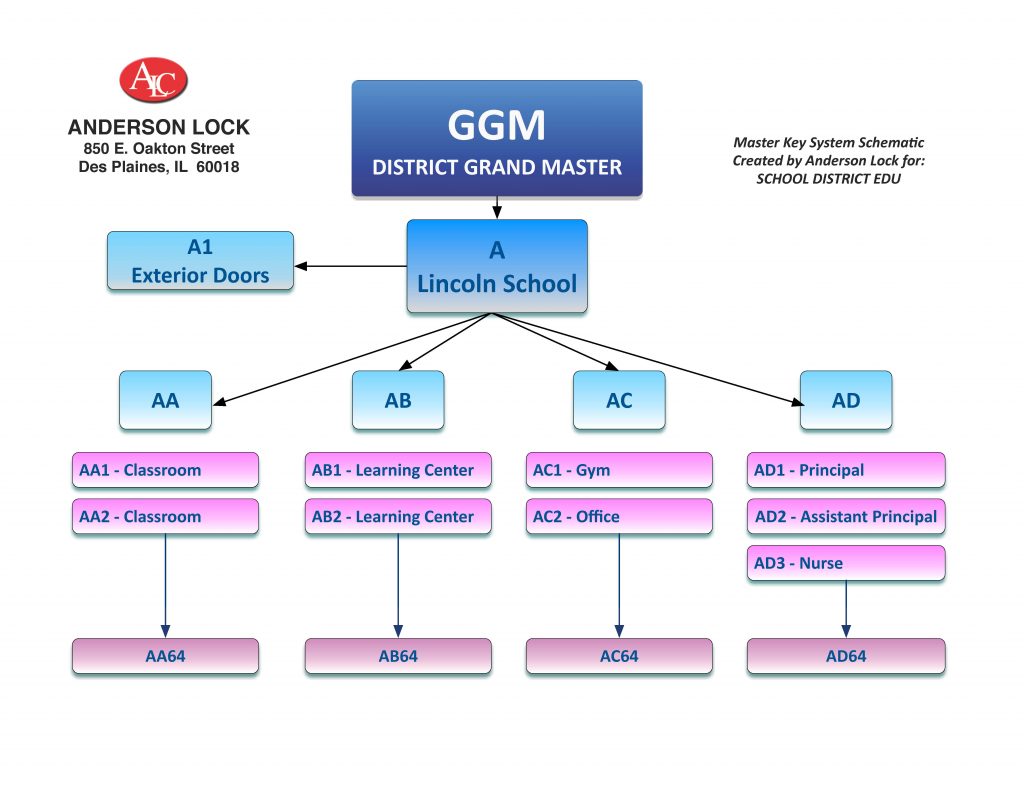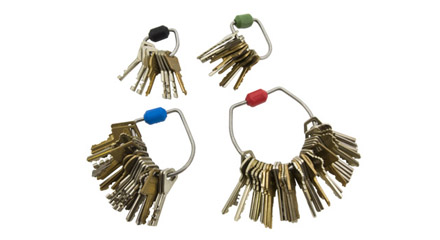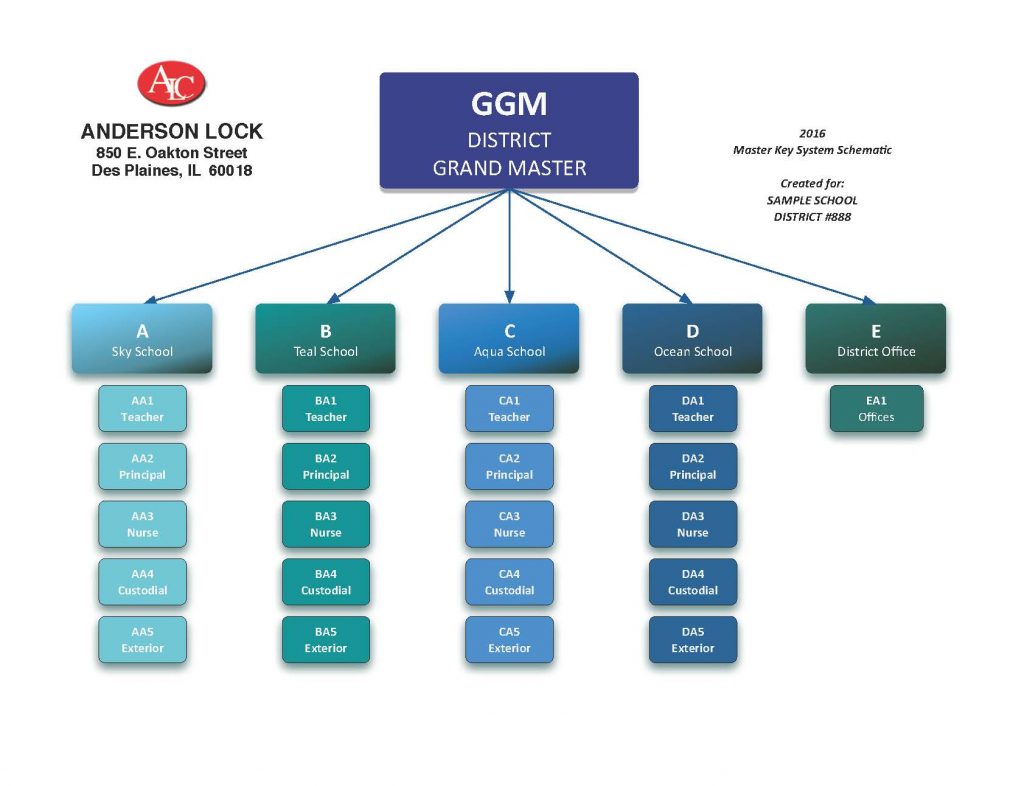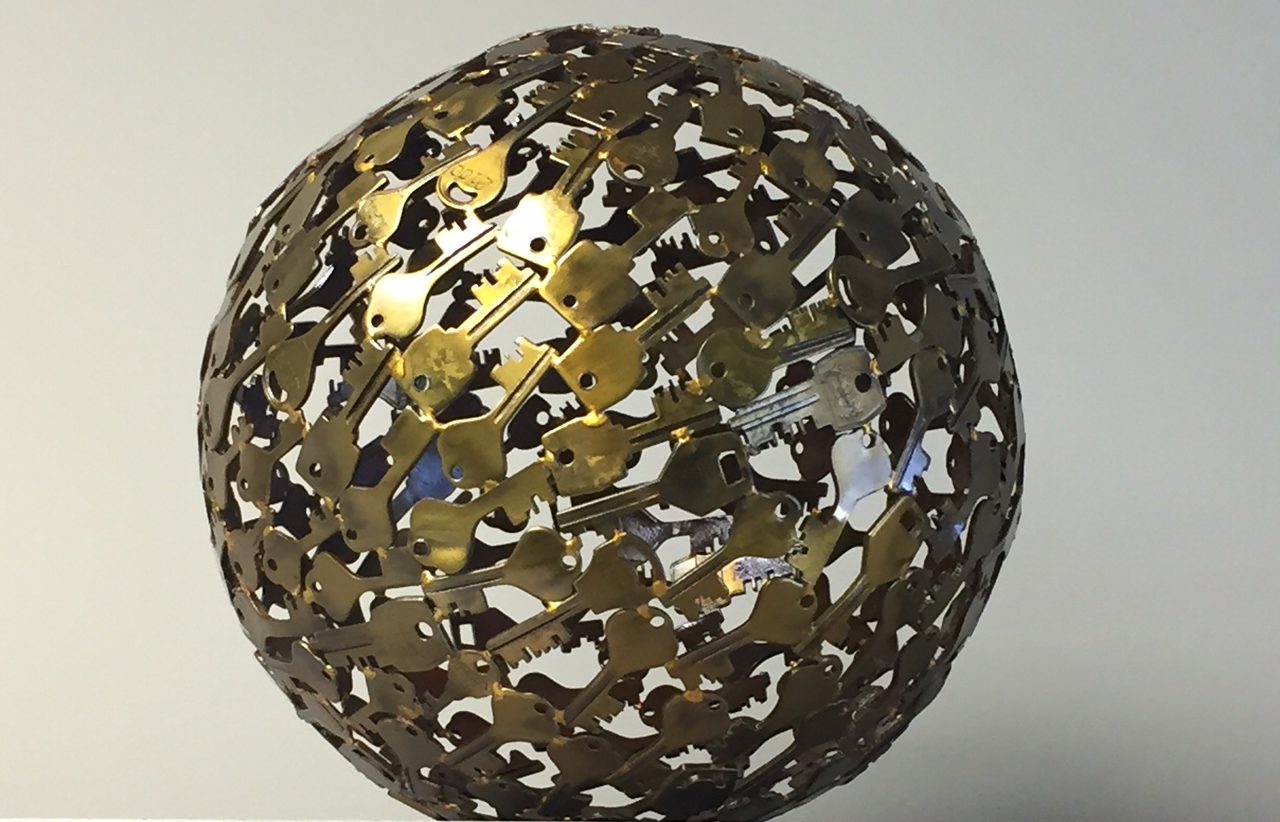Let’s start at the very beginning…
When you read you begin with ABC, when you count you begin with one, two, three. When you create a master key system you begin with ABCs and 123s! Letters and numbers are assigned to keys and lock cylinders, according to the bitting codes in a matrix we call a master key system schematic.

In this sample MK schematic, all the blue boxes represent master keys, all the lavender boxes represent change keys.
A master key system schematic is a blueprint for building security. Like an architect’s drawing, it translates a vision to both allow and restrict access to property. Any system providing different “access levels” must be tailored to fit the security needs of the specific building (or groups of buildings) where it is installed.
Through the use of time-honored symbols and abbreviations, for example, MK for Master Key and GGM for a Great Grand Master key, a diagram resembling a genealogical family tree or a corporation’s organization chart, is produced to communicate which keys will operate which lock, or set of locks. This schematic is used, much like the blueprint for a building, to communicate how the system will be used. Once this keying plan is approved, key codes are recorded, cylinders keyed, and keys cut. Usually, many changes are made to the plan, without impacting the final cost, before the locks, cylinders and keys are ordered from the factory.

Jim Riddle is one of Anderson Lock’s master key experts
Anderson Lock’s Service Manager, Jim Riddle, says, “I like to tell customers who have trouble understanding the theory of master key systems that it’s not how the key is cut that works the lock, it’s how the cylinder is pinned that “allows” the key to work.”
A master key system references a group of locks, and the keys that operate them, which are related in a hierarchy with one key at the ‘top’, which will fit into a large number of locks; and a large number of keys at the ‘bottom’ which may only fit into one lock. The fewer master key levels, the more secure the system. Careful planning is critical.

Master Key Systems reduce the number of keys required in a building, providing convenience as well as security.
Why would anyone want to install a master key system in their facility? Many reasons, but foremost is increased security related to controlling and restricting access. A secondary reason is convenience. Have you ever seen a maintenance worker with a heavy key ring hanging from a belt? A well-designed master key system reduces the number of keys required when one key opens many doors.
Andy Crestodina, a Chicago apartment building owner, put that thought this way, “You guys did such a great job with the master key system. The process was easy, organized, and 100% professional. I finally got rid of the huge ring with all those old keys!”
In a master key system, designated keys can open a number of pre-defined doors. Also, a named key (for example, AA1) can operate different types of locks (for example, door locks, cabinet locks, padlocks, etc.) as long as the cylinder inside them is of the same model.

If you look closely, you will see numbers stamped on each key. Cut, stamped keys are inserted into the mortise cylinders they operate, ready to be installed at a customer’s facility.
A master key is a key that opens several different locks, related in some way, within a master key system. For example, an elementary school may have a master key which will open all classroom doors. Classroom doors would each also be opened by a key which would only open that one classroom door. However, that classroom key could also open a closet within the classroom. In other words, a single key can open several locks if the locks are keyed alike (KA). If this elementary school is part of a district with a single master key system for several different school buildings, there may be a Great Grand Master key, which in this example could be designated (and cut) to open the exterior doors to the school as well as all the classroom and closet doors.
The top level key, referred to on the accompanying chart as the Great Grand Master, is able to open all doors of this sample security system, although each lock also has its own unique key. Thus, master key systems can be organized along departmental, or other functional groups, to allow supervisory or emergency access. The next level, called the Grand Master key, can open only designated doors, and so on. The first level or Change Key, usually opens only one door or room.
The nomenclature for Master Key Systems is fairly standardized throughout the locksmith industry, however, in this sample, the school’s master key might be called a “sub-master.” No two MK systems are alike.
Four of the many factors taken into consideration when planning a system are:
- the brand or manufacturer of the locks and keys (which is the biggest determinant of the level of security);
- how many locks are in the system;
- who controls the distribution of keys; and
- the locations of the doors (exterior, I.T., classroom, etc.).

Each key in a Master Key system is stamped with identifying letters and numbers to match it with a door name or location. (Keys in a large MK system would be stamped with a machine.) Note the skeleton keys hanging at the top left of this photo.
Any key that operates two or more unique locks can be called a master key. A master key will look like any other key within a master key system. It will be the same size and same basic shape. Only the cuts will differentiate it, unless it is stamped with identifying alphanumeric characters, like “GGM” or “GM” or “A”. A master key can be duplicated just like any other cut key, if there is authorization and a matching key blank in the correct keyway.
However, for a master key to work, there must be “master pins” inside the lock cylinders. When the master pins line up, the key and lock can turn freely. Tiny pins, color coded by size and shape, are inserted into a lock cylinder according to the codes assigned to that cylinder.
At Anderson Lock, unless a customer requests otherwise, each key is stamped with identifying letters and numbers when it is cut, to help match it with a door name or location. Sometimes, the top master key will not be cut or distributed to prevent its being misused. It must exist, at least theoretically, because of the mathematics, or codes, used to determine how the keys are cut.

About a million keys hang on hooks above well-calibrated key cutting machines, in our showroom. Our key code cutting machines use the latest computer technology and are calibrated to ensure accurate cuts.
In addition to being trusted to install and maintain MK systems for many of the Chicagoland university campuses, healthcare facilities, pharmaceutical corporations and transportation industry companies, our skilled lock technicians rekey cylinders, open locks, repair locks, and serve as a resource for technical information regarding all types of mechanical and electronic security hardware.When customers come into our showroom for the first time, they are astonished to see a wall filled with key blanks. They see nickel-plated keys, brass keys, hex keys, flat keys, four-sided keys, tubular keys, electric switch keys and, oh yes, skeleton keys. There is a lot of history and mystery related to skeleton keys, click here to read more.
Patent-Protected High Security Master Key Systems
High security keys are cut on special, patented key blanks, which must be cut on special key cutting machines, to operate high security cylinders. High security locks and keys provide the highest level of key control, and resistance to drilling, picking and attack. Neither patented key blanks, nor the key machines, are commonly available. Patent-protection assures that only certified individuals are allowed to have keys duplicated.

In a Master Key System one key can operate different types of locks (for example, door locks, cabinet locks, padlocks, etc.) as long as the cylinder inside them is of the same model. These patented, high security Medeco locks require authorization for key duplication.
Patent-protected cylinders maximize security and minimize the cost of access control. Master keyed cylinders provide a key management framework, and are easily integrated with electronic locks.
Anderson Lock is an authorized distributor for patented, high security key systems from Best, Medeco, Schlage Primus, Sargent and others. Government, educational and corporate customers recognize the vulnerabilities of unpatented keyways, and the dangers of poor key control.
In standard systems, if keys have been provided to tenants, employees or anyone else, even temporarily, copies can be made without authorization, decreasing security.
“High security cylinder” upgrades may be limited to exterior lock cylinders. Anderson Lock can, in many cases, recommend high security cylinders which remain compatible with an existing key system. The high security keys will operate the “old” cylinders (assuming they’ve been properly keyed by a trained locksmith) but the regular keys will not operate the high security locks. Master key systems and high security cylinders should always be considered when locks are replaced– either for architectural or security reasons.
When a client calls Anderson Lock expressing interest in “putting a master key system in a facility” we schedule a keying conference. Our master key experts meet with the client either at the facility where the system will be installed, or, if the system is for new construction, in a conference room where building blueprints can be referenced for floor plans and door names or numbers.
The goal of this meeting is to determine the:
- level of security required
- identity of decision-making personnel
- overall scope of the proposed system
- anticipated future expansion
- levels of keying
- number of doors and door numbers or names
- timetables and estimated costs.
For large systems in existing buildings, the number of doors and door names / locations, may need to be determined by a “walk-through” with our locksmith and a client’s representative. Master key systems can only be expanded if expansion was built-in when the system is created, so careful planning is imperative.

In this sample schematic there are many more schools, and more doors are Keyed Different (KD).
A custom, colorful schematic will be created at Anderson Lock, and presented to the client at a subsequent meeting. This helps the client visualize the proposed system’s hierarchy, and make changes before cylinders are ordered from the manufacturer.
Anderson Lock designs, installs and maintains master key systems, often specifying restricted, patented, high security key systems. Thousands of master key systems are recorded in our code books using hundreds of keyways to meet building specifications. Skilled lock techs use well-calibrated key machines to cut countless original and lookalike keys every week day of every year since 1960.
Maintaining a master key system means that we keep records of each key code used. If locks need to be rekeyed, or locks need to be added to the system, a system with expansion built-in will have codes available to be used for cutting new keys and pinning new cylinders, without duplicating any codes already used, which of course would threaten the security of the whole system.
Anderson Lock is an industry leader, always on the cutting edge. Today’s trend toward electronic locks incorporates master keying concepts, and many of our mechanical master key system customers, like High School District #220, have called on us to install electronic access controls. Mark Appleby, District #220’s Director of Transportation and Operations, pushed to have Anderson Lock install access control security locks at Burbank’s Reavis High School. He said, “Anderson Lock has been our only security lock provider for the 12 years I’ve been here. You installed our Master Key System, and there’s a high level of trust. This year, when our security consultant recommended an electronic access control system that ties into our security cameras, I contacted (Anderson Lock).”
So here you have the ABCs and 123s of Master Key Systems.
View Master Key Systems Services



